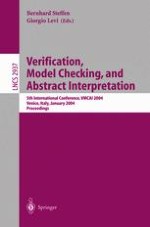2004 | Buch
Verification, Model Checking, and Abstract Interpretation
5th International Conference, VMCAI 2004 Venice, Italy, January 11-13, 2004 Proceedings
herausgegeben von: Bernhard Steffen, Giorgio Levi
Verlag: Springer Berlin Heidelberg
Buchreihe : Lecture Notes in Computer Science
Enthalten in: Professional Book Archive
